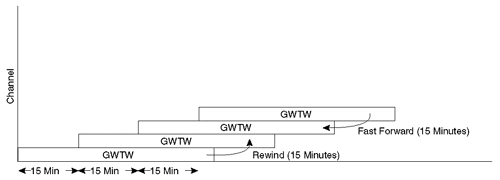Near Video on Demand
An alternative to VoD is near video on demand (nVoD) , also known as advanced/enhanced pay-per-view or staggercast. Near video on demand provides widespread availability of movies without the need for a dedicated point-to-point connection between the viewer and the video server. This reduces server and network resources when compared with VoD, but at a loss of consumer flexibility. Given experience with pay per view, consumers appear to be willing to accept these limitations. With nVoD, the viewer is offered the same content continuously, whereas for DBS or PPV, the content is offered once. nVoD is an experimental service undergoing consumer research.
Service Description
With nVoD, the service provider elects to offer a particular movie beginning at certain intervals, say every 15 minutes, on a small number of channels, say four. The interval is called the stagger time, hence the term staggercast.
The network provider decides when to initiate the movie and on which channels. The subscriber tunes to one of the four channels. If the viewer simply watches the movie from beginning to end, this viewing experience is exactly the same as tuning to a movie on any broadcast channel.
However, if she wants the equivalent of rewind, she can switch to another channel that started 15 minutes later. If she wants only 5 minutes of rewind, she's out of luck. For fast forward, she can tune to another channel that started 15 minutes ahead of the program stream she first started watching. It's not precise rewind or fast forward, but the objective is to reduce cost by reducing the number of dedicated user connections, each of which consumes identical bandwidth. Four channels can service an entire viewing area using nVoD because each of the four channels operates in broadcast mode. This is in contrast to VoD, where four channels service exactly four viewers.
Stagger time can be reduced to 5 or 10 minutes, but this increases the number of channels allocated per movie.
Figure 1-5 depicts the operation of nVoD. In this example, Gone with the Wind (GWTW) is offered with 15-minute staggers over four channels.
Near video on demand fits the definition of push mode. The provider pushes the bit stream to the subscriber rather than the subscriber pulling bits from the server for exclusive use, as is the case for VoD. The royalty, compression, and set top costs are the same as those for VoD, but there are substantial server and network savings.
A typical stagger time between showings of a movie is 15 minutes. Because movies last about 2 hours in length, eight channels are needed for an even distribution of 15-minute staggers. The viewer has a limited amount of time to watch the complete movie, say, 6 hours. This permits lots of rewinds. Service providers typically offer three different nVoD movies at a time, thereby requiring 24 digital channels for the total nVoD service.
Figure 1-5. Near Video on Demand

Key Benefits
Compared to VoD, nVoD offers substantial savings to the service provider by reducing server and network resources. Eight channels provide service to exactly eight viewers using VoD. But eight channels of nVoD can service a viewing population of thousands with 15-minute staggers. This is especially useful with recent releases, where there is a high probability that many viewers will be watching the same thing at roughly the same time.
Key Challenges to Near Video on Demand
Near video on demand still requires a large number of channels. In our example, 24 channels were needed to show only three movies. Cable and DBS operators will need to allocate channels to VoD or nVoD that would otherwise be used for standard broadcasting. Because many operators are strained for channel capacity, will they allocate enough broadcast channels to support an nVoD service? Or will they prefer to offer more network programming instead?
At the consumer end of the service, will consumers accept the loss of control to which they have grown accustomed with their channel-changers? Fifteen-minute staggers may not satisfy users who want finer granularity of rewind and fast-forward timing.
As with VoD, nVoD manufacturers must pay royalties and deal with a lack of digital video content.
